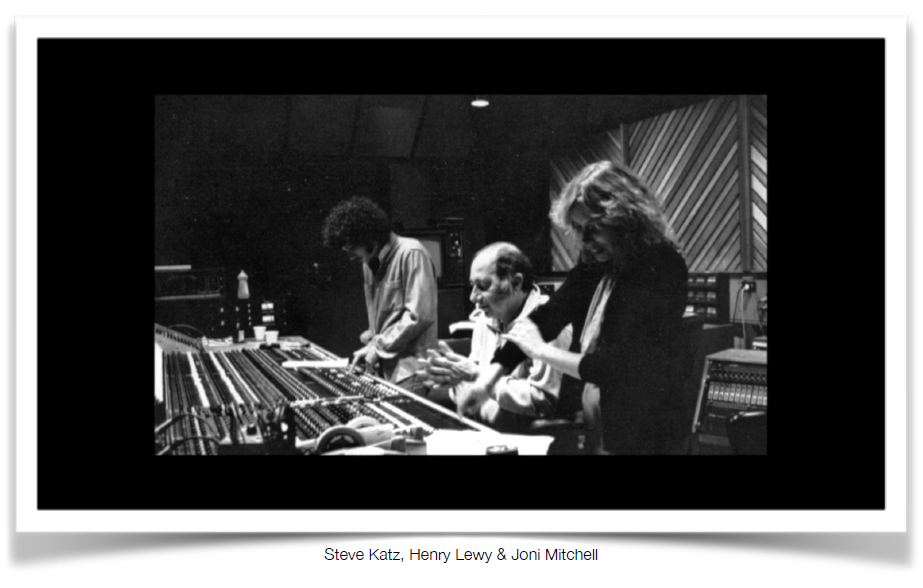
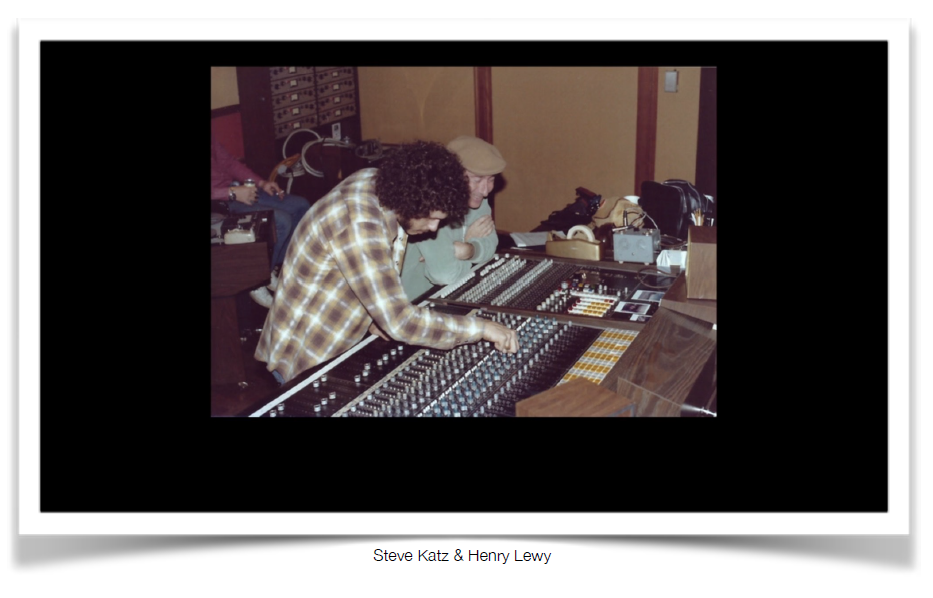
Steve Katz interviewed by Dave Blackburn
It is well known that Joni Mitchell and her engineer and creative catalyst Henry Lewy worked as a partnership to make all of her 1970s albums, in a pretty closed door operation. However, on Hejira, Don Juan's Reckless Daughter and Mingus, a third production partner was involved, from running the tape machine to mic placement, from tracking through mixing - A&M staff engineer Steve Katz. I was able to connect with Steve by phone and he kindly talked to me for several hours over three days about his years making some of Joni's most interesting albums. Steve, [no relation to the Steely Dan producer Gary Katz] was at A&M from 1974 to 1983, nine important years in the booming record business at that time, and he helped create some of the great albums of that time coming out of Los Angeles.
Background
Steve began working at A&M studios, age 22, sweeping floors and making coffee, following the apprenticeship path almost all studio engineers used to climb back then.
SK: "I knew nothing" he says. "I always had a passion for music and played some drums, guitar and bass when I was young. When I first started learning they would eventually throw you in as an assistant to run the tape machine for people. A&M had publishing companies Almo/Irving and Rondor, and we used to do demo sessions for the staff writers like Allee Willis, [writer of Earth Wind and Fire's September and Boogie Wonderland, among her many other hits], and so many other writers on staff there. It was really amazing because we had the tape library upstairs, with all the reels and reels of tape up there - so much stuff that nobody would ever hear - all these songs that never got picked up just filed away up in this library. There were the multi-tracks, the two-track mix down tapes, and every artist all the way back to Herb Alpert and the Tijuana Brass. It was pretty amazing." [Herb Alpert was the A in A&M; he and Jerry Moss - the M - purchased the studio in 1966.]
First job - Assistant Engineer/Tape Operator
DB: "Did the job of tape operator get replaced when remote controls came in?"
SK: "Not really. Especially doing overdubs, it's very tedious. You're going over one line at a time, or even punching a word in. The engineer really has enough to do recording-wise and being available for the producer. You certainly need someone that's confident back there and knows what to do without having to turn around and tell them. If something got accidentally erased you'd have to replace it." [In today's digital tape-less recording that is not the case.]
DB: "Punching in back then wasn't that seamless was it?
SK: "You actually had to be a little ahead of the part you were trying to punch in because the sync head and the record head had a couple inch gap between them. You'd have to compensate for that, so, even if you thought it was right on time, you would be late; you'd always have to anticipate. It's not like nowadays with digital."
A&M Studios
A&M Studios was a complex of buildings (formerly the Charlie Chaplin soundstage) at La Brea and Sunset in Los Angeles. It consisted of four recording studios, A,B,C & D, three mixing suites and three cutting rooms where staff mastering engineers, like Bernie Grundman, would prepare the finished tapes for vinyl reproduction.
Joni Mitchell's early albums were recorded mostly in studio C, the smallest and most intimate one, measuring a mere 14' x 21". Crosby, Stills and Nash and Carole King also used this room. Joni felt comfortable in this small space, even when tracking with a full band. But, as Steve noted, "if your preferred room was booked you'd have to use whichever one was available." Consequently Joni moved between studio B and C pretty often, and her favorite brown Steinway, of the four 9ft Steinways A&M had, could be moved into whichever room she was working in.
SK: "If you had a full setup with guitar, bass, drums and piano, it was tight, so you didn't really have to worry about any leakage because people weren't spaced out. A lot of the musicians liked that because they could see each other really well. So actually you could make that room work FOR you, if you knew how to set it up. We had a few configurations that always worked and we never really varied from that because 'if it ain't broke don't fix it.'"
The tape machines
Joni Mitchell's early records - Ladies of the Canyon, Blue, For the Roses were recorded on 8-track Scully decks, but by 1973, in time for Court and Spark, A&M had upgraded to 16-track machines offering her far greater possibilities for layered guitars, backing vocals, strings and such.
SK: "We started out with three Scully 16-track machines and one 3M 16-track, the "34" design. When the 24-track machines came out (about 1976 or 1977) we got these 3M machines (the "78" design) with remotes that looked very intimidating that were twice the size and had twice the number of buttons. I remember we got the first 3M 24-track. It really took some time to learn, as it was different. The Scully machines were old technology that relied on relays, but in the 3M machines the relays had got a lot better."
The consoles
SK: "Early on all but one of the consoles at A&M were made by Howard Holzer Audio Engineering [HAECO]. Then they got an API console in studios A and B and a Quad 8 console back in D. Of course everything got modified by the maintenance techs. Later on, A and D got Neve consoles with flying faders and one of the APIs got moved over to C. Studio C [in which Joni had mostly worked] was the last to get an upgrade and during 1976 still had the rudimentary HAECO console [pic below] with just eight busses and an EQ section with only three fixed midrange bands - very old school. The maintenance staff had gone through it and modified everything, the preamps, you know - nothing was standard. And we were able to patch around a few things in the patchbay to bypass some op amps." [op amps can color the sound negatively unless they are of the highest quality.]

DB: "I do mastering in my studio, and listening to some of those Joni records I notice there is a very consistent spike at 2.8kHz on the vocal and the piano. It must have been an EQ choice as it's not what vocals or pianos naturally sound like, and I'm wondering if that console had a fixed EQ frequency band at 2.8k that Henry would engage. It's very noticeable from Ladies of the Canyon all the way through Don Juan"
SK: "Yeah, I think if I remember correctly, one of the fixed settings was at 2.8k. And it may have been the monitors also [affecting Eq decisions]. But audio has come so far. They would try and tune the rooms but every room was different. And then Bernie [Grundman], who did all the mastering, he had these wall mounted Tannoys in his room - it sounded different no matter where you took it....(laughing) That 2.8kHz band was the radio frequency that pushed the vocals way out in front, and everybody wants the vocals out in front. When I was mixing, I always wanted to pull her vocal back a little bit and put it in the track more, but they would keep pushing it up!"
The reverbs
DB: "Can you talk a bit about the reverbs that A&M had?"
SK: "Yeah, we had a lot of above-ground Live Chambers. [An empty enclosure sometimes with plaster walls with a speaker at one end and one or two mics at the other - signal from the console could be sent to the speaker and brought back into an auxiliary return fader as the echo/reverb - some studios had wonderful sounding chambers that lent the records made there their distinctive sound. Capitol had seven underground chambers that were a highly prized part of that studio's sound.] Every one of them had a de-humidifier that would run at night as they'd always have water in them from condensation.
SK: "And then we had a lot of EMT Plates." [the EMT Plate 140 is a German electro-magnetic way of producing reverb using a heavy suspended steel plate with pickups on it - its sound is very familiar to fans of Pink Floyd's Dark Side of the Moon as it was the only reverb used on that record]
DB: "How did they keep the traffic noise from La Brea and Sunset Blvd from bleeding into the chambers?"
SK: "I'm pretty sure they had cut the foundations to isolate them. For the most part we were never really affected by anything from outside."
DB: "Did Joni and Henry typically go for the plates or the chambers?"
SK: "It depends, because the chambers were pretty much set in their decay times, but you could always adjust the decay on the plates, and all the plates sounded different. You could patch the plates from the Echo Room into whatever room you were using. Also, I remember Herb (Alpert) renting a couple of the reverb chambers at Capitol via a T1 phone line. [this is an extraordinary revelation, as Capitol's famous underground echo chambers were many miles away, but their sound could be 'rented' by other studios when not in use at Capitol, and accessed remotely in a realtime two-way connection by a fast phone line, even back in the 70s.]
SK: "It wasn't cheap, I can tell you that much! As our chambers at A&M were always wet, sometimes the equipment inside wouldn't work - you might have one mic out of action and only be able to get a mono echo return instead of stereo.
DB: "I read that the recording for Hejira was mostly complete when Joni was told about this bass player from Florida that she might really like. Joni apparently flew him out to L.A and he ended up putting down his parts on four songs. Is that how you remember that?"
SK: "Yeah, and I don't know if he replaced any of the other tracks but she pretty much gave him free rein because she had already listened to the Weather Report stuff, I guess. I remember, he came in, and we met him. He was so different, with the fretless bass and an Acoustic 360 amp. We mainly ran him direct but we still miked his amp and combined those sounds together. He was pretty adamant about using some of the amp sounds - he liked that."
DB: "And he liked to double and triple track himself, right?"
SK: "Sometimes we'd speed the tape up - go double speed." [Probably that low C "bomb" where he enters during Overture on Don Juan was achieved by playing his lowest normal C with the tape running at double speed. When returned to normal speed his note would be an octave lower, and below the range of a four string bass guitar.]
SK: "If we were going to double a riff, he knew exactly what he had played; he would play it perfectly. He was amazing, the guy was just brilliant! Karen Carpenter was like that - she could double and triple her voice, singing an inch off the mic. She was the most amazing singer I'd ever worked with."
DB: "So working with Jaco was a pleasurable experience, then?"
SK: "Ha, oh yeah. He was new, he was different, he was completely out of the box. Other bass players were like vanilla compared to him. He was a rainbow - any color you want, he could do it. I'd never seen anybody like him, and he was just a kid!"
DB: "Well she was always looking for players who could paint with sound. That's why she liked Wayne Shorter too..."
SK: "It wasn't always what Wayne played; it was what he didn't play. That's how you have to listen to Wayne Shorter. He would play, but it was always the holes that he would leave. These guys were just phenomenal. She was starting to create with all these new sounds that she had now in her toolbox."
DB: "We haven't mentioned Larry Carlton yet, but he was another guy who could paint with sound and really interact with a track"
SK: "She used him, [and later Steve Lukather, on Wild Things Run Fast] Those guys were very creative when they played. The way her melodies were, Larry could paint a really nice picture with his guitar."
On Blue Motel Room
[There is a very good chance, though Steve doesn't remember for sure, that Joni's guitar on Blue Motel Room was recorded at her home and then transferred to the multi-track at A&M for the rhythm section and vocal overdubs. It has a 'home recording' room sound, and prominent tape hiss that would not have been there if it had been recorded there.]
DB: "Were you a fan of Joni's outside of being in the studio? Did you listen to her records?"
SK: "It's funny. I graduated high school in 1970, and then in '71 or '72 I went to Valley College, in the San Fernando valley, and I was taking a lot of general classes; I wasn't sure what I wanted to do. And in the library they had turntables. I remember, for the longest time, if I had an hour or two between classes, I used to bring in Joni's first three albums, 'cause I loved those three records. I'd put them on and people would come in and say 'do you mind if we listen to that with you?' She was widely popular."
DB: "So when you did get to work with her, that was pretty exciting then?"
SK: "Yeah, I loved these records growing up, and here I am all of a sudden working with her!"
DB: "Well, so what was she like to work with?"
SK: "Oh, she was amazing. Henry and I would never really know what we were going to do when she'd come in. We were ready, we always had a vocal mic up, but we just had to wait and see. She would go home at night and work out parts and then she'd show up and say 'I want to work on this.' One time she showed up with Glenn Frey and J.D. Souther to do backgrounds [for Off Night Backstreet]. Jaco would come in to the studio, and he'd be waiting with us, and she'd show up an hour or two hours late, and then we'd start, but nobody really knew what we were going to be doing."
DB: "So once Jaco was involved, he stuck around for the remainder of the project?
SK: "Yeah, he pretty much showed up almost every night." [especially for the DJRD and Mingus albums.]
On Hejira guitars and effects
SK: "She had a few guitars on Hejira, none of them solid body."
[they were most likely Gibson hollowbody arch tops with flatwound strings - the Ibanez GB10s she later toured with in 1979 and 1983 were not available until 1978. The exact guitars she used will probably never be known as neither Steve nor Joni remembers what she played, and Henry is no longer with us to ask.]
SK: "She would go to Guitar Center and try out stuff" [she was also a regular customer at Westwood Music, owned by luthier Fred Walecki, who was her guitar tech/advisor.] "She'd come in and lay down things she'd been rehearsing at home; she never really did her rehearsing in the studio.
DB: "And the pedal effects she was using on the record?"
SK: "Yeah, all that was done either at Guitar Center or at home. A lot of time these guys would show up with stuff that hadn't even been released yet. They had deals with these companies who would give them stuff to try out."
[The Boss CE-1 chorus/vibrato pedal was released in 1976 and was the first chorus effect in a pedal format to be available; it is very likely a part of the guitar sound on Hejira, along with a phaser pedal giving a "liquid" swirling effect - likely the MXR Phase 90 which had been released in 1974 and was the first product sold by MXR. Then one or two more layers of guitars, including an acoustic, would be added and then be panned left, center and right, giving the album its lush panoramic texture full of modulated movement.]
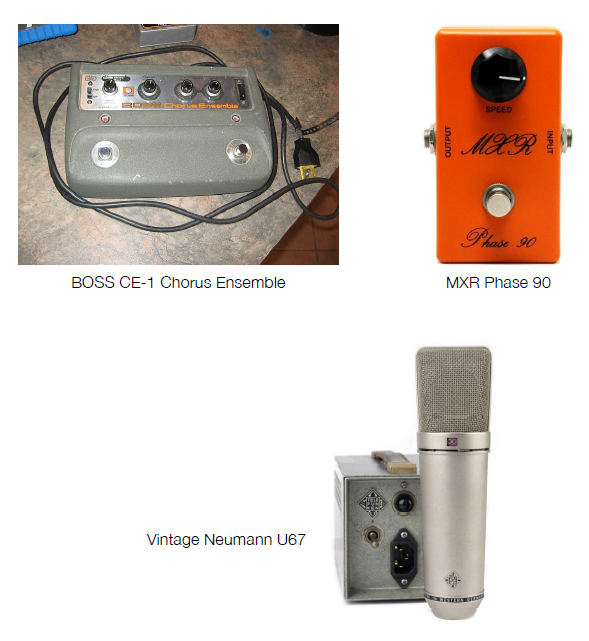
On microphones
SK: "We used a particular Neumann U67 tube mic for her vocals - we had, I think, three or four of them at A&M. So when we were done working, that mic went into my locker."
DB: "What did you use to mic the piano?"
SK: "Neumann U87s. They are just good mics. When we were cutting piano live with drums also in the room, the lid was only open about six inches, and you'd stick the mics in there the best you could, and then it was covered with a heavy leather cover which had openings to stick the mics through to keep the leakage out. It always seemed to work; that's how we cut everything."
On Henry Lewy
DB: "How was it working with Henry?"
SK: "Henry was an amazing guy. I miss him dearly. He was never down. He knew everybody, and everybody knew him. People like Leonard Cohen would stop in to see him. He'd come in early, we'd go out to dinner or get some Indian food or something and we'd talk about what we were doing, and then go back to the studio and wait. He'd always consider himself more of a catalyst than anything - he would just bring things together. He'd have his input, but he always was very harmonious. Joni was the one that knew what she really wanted and he was there to make sure that it got done, and that was my job too.
DB: "She became pretty savvy about what you can do in a studio early on didn't she?"
SK: "In the beginning she was pretty reserved. They wouldn't let anybody come in; they'd lock the studio. She was kinda insecure in the beginning, but that all seemed to go away as she got more and more comfortable - she became very savvy."

On tracking
DB: "Tell me about compressors and stuff. Did you ever track with compression?"
SK: "For the bass and vocals, we always used a limiter, but for the most part the other tracks went down pretty clean."
DB: "So were the studios pretty well equipped for compressing multiple things?"
SK: "Back then, everything was pretty much outboard. Very little was built into the mixing boards at that point. A&M had a mic room that had all the outboard gear in it, and you'd just go in there and get what you needed and bring it into the studio.
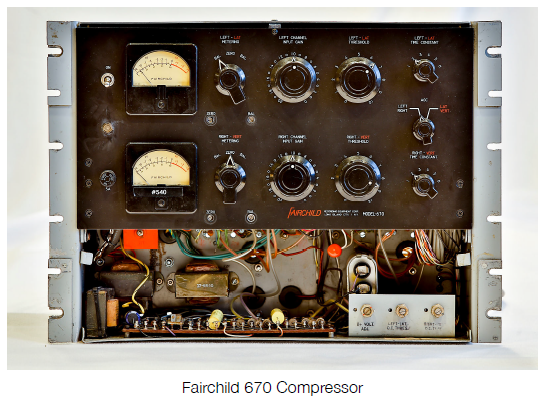
DB: "Were they mostly Teletronix LA2a and Urei 1176 limiters?"
SK: "Yeah, and we had a Fairchild that was pretty good! [The Fairchild 670 and 660 are today the most prized and most expensive 1950s compressors in the world - the 670 weighed 65lbs and had 14 transformers and 20 vacuum tubes! Today one sells for nearly $30k!]
SK: "Later on we got dbx compressors and Kepex gates. The maintenance guys would always go through all these and beef up the electronics so they'd have less noise; those guys were on top of it."
SK: "Studio C was the only studio that didn't have an isolation booth, so we had to make one out of gobos [movable partitions on casters]. When we'd record Joni we needed her to lay down a guide vocal - sometimes with acoustic guitar - along with the drums, so we'd isolate her as much as we could. Also we may occasionally have tried to put her in the control room underneath the monitors so as not to feed back. Then she'd lay down a rough vocal to get the timing down. We'd finish all the overdubs, and finally she'd come in and start doing her keeper vocals. We'd lay down four or five tracks of lead vocals, and then we'd play back each track, and she would mark down, line by line, what was good on what track. And then we'd bounce all her selections to an empty track to make the master vocal. If she came in at 8 or 9pm, we'd work at least till 2am or 3am every night."
SK: "A lot of times, things didn't work out. I remember James Taylor showed up one night, and they tried doing some stuff, and we worked all night and got nothing, absolutely nothing. Sometimes it works out and sometimes it doesn't, but you don't know until you try."
DB: "Were you under any time constraints, or did she have as long as she needed to make these records?"
SK: "We didn't have any time constraints, ever! When it got done, it got done. She sold a lot of records, you know, so you gotta give an artist the latitude to be able to create. You know, at A&M, we rarely saw any A&M label artists record there. Supertramp showed up, The Tubes showed up a couple of times, but for the most part it was people on other labels that would work there. It became us, and The Record Plant and Sunset Sound, those were all very popular studios."
"Henry (Lewy) suffered from rheumatoid arthritis and his ankles and his wrists would swell up - it was very painful. A lot of times I would end up taking over, and he would lie down on the couch up front. They didn't have the medication for it that they do now, so he really had to ride that out. His wrists were swollen and inflamed - it even looked painful. So at those times I was doing everything. I would go to the market - she (Joni) would like green grapes and I'd set them out in the studio - and then I'd set the studio up, and check out the tape machine. Then I'd have to run the machine, do the recording, everything for the whole night.
On mixing
DB: "So, would the albums always be mixed in one of the mix rooms?"
SK: "Yeah, pretty much. You could mix in one of the studios. Sometimes you'd do a whole project in one studio since you were used to the monitors. But every room was equipped with the same monitors - Altec 604Es."
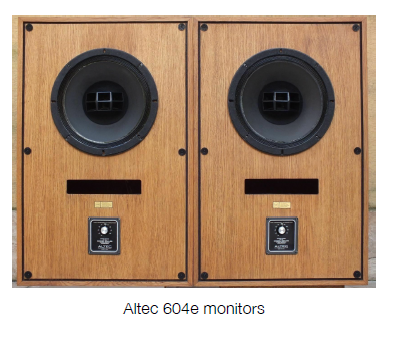
SK: "They'd set up all the rooms the same...or tried to, but every room sounded different. We also had Auratones for nearfields; the little 5" cubes. [Auratones were supposed to approximate the sound of car speakers.] But I remember working with Bruce Swedien, [Michael Jackson's engineer] and he had some early-model JBLs, and he'd come in and mix down to those. He knew those speakers really well. Everybody always wanted to hear Bruce's stuff.
DB: "Were you involved in the mixing of Hejira?"
SK: "Not all the time. That was really Henry and Joni. It depends on if Henry needed me. A lot of times I'd go and work on other projects in other rooms. But I was definitely involved with the mixing on Don Juan and Mingus.
SK: "A lot of Don Juan was recorded in studio B (and in A when B wasn't available) on the API consoles. I think we even mixed it in the studio also rather than in one of the mix rooms. We used whatever was available. I was especially involved in recording and mixing Don Juan because Henry was really suffering with his rheumatoid arthritis. When we did Mingus he was starting to feel better."
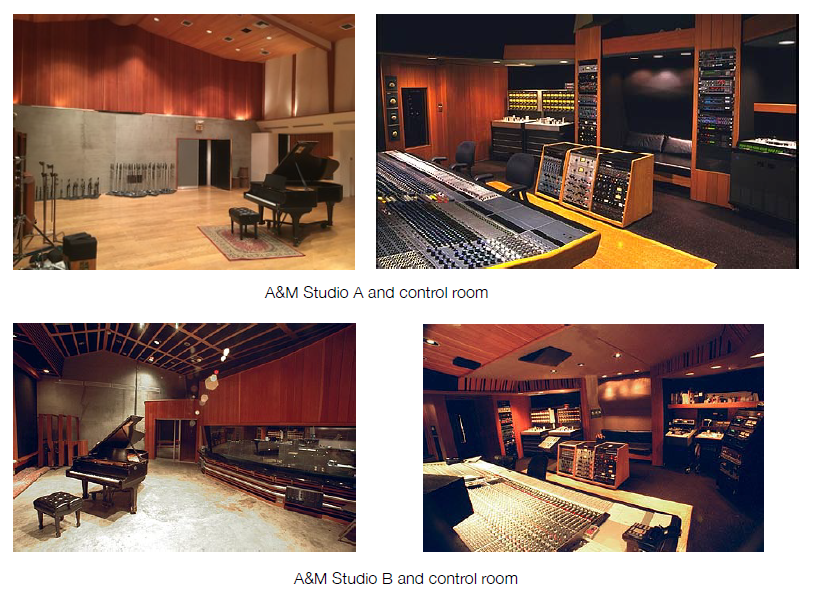
DB: "Don Juan was a REALLY different album, not just for her, but for anybody."
SK: "Yeah - it covered a lot of different things - with Jaco and Wayne, and the percussionists Manolo, Airto and Alex Acuna. They were there for a lot of the tracking stuff - that's why we needed a bigger room. I remember setting up in A when we did Paprika Plains. Isn't that the one where John Guerin comes in with these thundering drums? He came into the control room and said 'I've never heard my drums sound so good.' He was really blown away. Studio A was the biggest one, usually used for live strings or huge sessions. There were these curtains that you could draw and cut the room in half and that's what we did for that track. We set his drums up just in front of the curtains, up on a riser, but we left the curtains open just as wide as his drum kit. And we tried to recreate that on another project, but for whatever reason we could never get back to that. We used the same mics and the same position of the kit but I can only think it had to do with the other mics in the room. He was kind of disappointed that we could never get that sound again, but we tried and tried."
DB: "How did you mic his kit back then?"
SK: "Usually an SM57 on the snare. On bass drum we'd use a Shure SM7 or a Sennheiser 441. For the overheads we had these Telefunken 251 tube mics that were great, but if those weren't available we probably used Neumann U87s. SM57s on the toms, and on the hihat I liked the Neumann KM84; it wasn't too bright, it didn't spit. That was usually it."
DB: "And Jaco. Were you still miking his amp and merging it with his direct signal?"
SK: "In the beginning, we miked his amp, but after a while we'd be in the control room and just go direct."
SK: "Everybody was trying to get Joni to cut down Paprika Plains to eight minutes. And also the long percussion one [The Tenth World]. The big contention was the drummers all wanted writer's credit on that song. I think Elliott [Roberts] was trying to convince her to cut the song down so they didn't have to pay them as much. In the end I think she [Joni] won out. And it was probably a one-time payout - you're not going to see many residuals on that.
On Paprika Plains
DB: "Let's talk about Paprika Plains, which takes up a whole side of one the the discs."
SK: "The strings were recorded in New York at RCA studios. Henry and I went out there, but in New York the studios are all union and we weren't allowed to touch anything! And from there we flew to England to overdub Jaco [as Weather Report were on a European tour at that time]. I had made safety copies of everything before we left. I think Joni shipped the tapes over there, but coming back I had them under the seat in front of me! We booked a studio there - I think it was Basing Street Studios - and Jaco would come in and put down whatever we needed him on."
DB: "What do you recall of the famous 'out of tune strings' issue on that piece?"
SK: "Yeah that was an issue that we really had no control over. Going back in retrospect, it might have been cool to sound an A440 tuning note before the count off so you could bring the tape to the right frequency. Because that piece was patched together in sections we had no control over that stuff. Joni was aware of all that - at some point you just have to think that it's organic. This was all raw stuff; we're talking mid-70s.
DB: "Those percussion tracks - were those done in studio A as you needed more space?"
SK: "If they were small overdubs they could have been done anywhere - even in C - but the stuff that was tracked together live was done in B. For the percussion tracks we mainly used U87s [the workhorse condenser mic in all good studios during the 1970s] They brought in Airto (Moreira) and he was incredible - I hadn't worked with him before."
DB: "What were your feelings about the cohesiveness of the project? Were you just concentrating on one song at a time, or were you feeling like you had to make this into a coherent album?"
SK: "You know, we just did what was put in front of us. All that stuff was left up to Joni to make it coherent. As diverse as that record is, with so many different moods and feelings and orchestration and instrumentation, we set up for whatever was needed to be done. And when we finished mixing, having things put into a sequence, that was really all her. We all had some input but in the long run it came down to her decisions - she was the artist."
DB: "What was she like to work with?"
SK: "She was easy, just a really wonderful person. She was pretty focused on what we needed to do. She was always open to trying things, but she always had a focus on how she wanted it to be. I wouldn't say she was real demanding, but whatever it was she needed done, we would just go ahead and do it. So, it was a really great workflow. And we could be in the studio for as long as she wanted to be there, even though those rooms were well over $100 an hour, at the time.
DB: "Do you mind me asking what they paid you back then?"
SK: "(laughs)....ah.....when I first started there in 1974 I made $95 a week, gross. Take home was about $75, and I was able to afford an apartment! I also had a little Volkswagen bus. A&M was actually pretty good; I mean, if you didn't work you still got your weekly, and if you did overtime they would pay you time and a half. When I tried to buy my first house, my dad said 'you don't make enough money' - 'but I have overtime', I said. He said 'but you can't depend on that!' I went ahead and bought this house for $76,000!
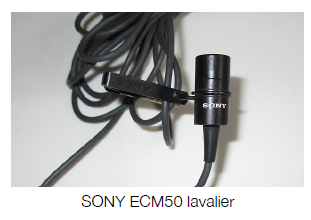
DB: "What did you use on the acoustic guitars on that album?"
SK: "If she was going to play live [with other players recording simultaneously] a lot of times we had this Sony ECM50 which we'd tape on to the guitar and drop it into the open hole and then you'd have to roll a bunch of bass off as it's a boomy mic, and then put something directional on it from in front and mix the two.
Sometimes we'd keep it and pan the overdubbed guitars to the sides. We may have used some AKG 414s, but I wasn't a big fan of those because to me they always sounded brittle.
DB: "What do you remember about the Mingus sessions?"
SK: "It was great cause it was really full-on jazz, and the guys that were coming in were just incredible. But the record company really wasn't happy. This was a real departure for her, and she obviously didn't care....she's an artist. She was really embracing the jazz stuff. Jaco, I'm sure, was a huge influence, and she really liked Weather Report. With Jaco knowing everybody in that world it made it a lot easier for her to transition. She had always used her voice like an instrument, even back on her first album, so in a way this was the same thing, but in a jazz context. Not playing an instrument [on four of the six tunes] she really became a singer. What she was doing was already hard enough!
DB: "There are quite a lot of today's jazz singers who are only now discovering Joni's jazz work. After hearing Mingus and the Both Sides Now album they are just blown away by what a bona fide jazz vocalist she was.."
SK: "Yeah, and when we were doing it she wasn't getting any recognition.
DB: "So, originally the pianist on Mingus was Jeremy Lubbock, and Jaco was not happy with him."
SK: "Yeah, Jeremy was a friend of Henry's. He was British. He was an arranger as well. Henry brought him in to work on another project - I don't remember if it was Minnie Ripperton - and when Joni was needing a piano player he recommended Jeremy. But he really never fit, and Jaco was not happy. He wasn't enough of a jazz player. It was kind of painful, because everybody else just fit right in. Then Herbie showed up, and he was awesome! I couldn't believe I was working with Herbie Hancock!"
SK: "I was also working on other projects at the same time, with George Harrison, Carole King, Manolo Badrena, Donovan's Slow Down World, Minnie Ripperton's album, some Carpenters' sessions.
DB: "What was it like working with the Carpenters?"
SK: "They were so good, and they were super nice. So talented. And Karen was just unbelievable. One of their guys was on vacation so they asked for me to come in and help Roger [the Carpenters' main engineer.] A&M was doing so well at the time. Frampton Comes Alive was another one from that time, and it sold 16 million copies! Then they signed Janet Jackson, and that was huge. But after one year her contract was up and Sony offered her a multi-million dollar deal, and A&M couldn't compete with it, being just an independent label.
Jaco and Mingus
SK: "Jaco was always there in the studio, unless he had something with Weather Report. We'd have to reel him back in as he'd start pushing his bass up in the mix louder than the vocal! He would always test the boundaries. That's how he was. I was so fortunate to be exposed to him. Stanley Clarke was already popular, but Jaco was really an amazing musician. Like a good football player, he would elevate the rest of the team. His personality was really uplifting. Joni was really fortunate that they were able to bond so well together, musically and professionally.
DB: "In general did Joni get keeper vocal takes in four or five takes or did it take longer?"
SK: "No, she practiced at home. We'd often get a good vocal and just punch in a line or two. But sometimes after we'd compiled a great vocal from five or six takes, she'd come back a week later to see if she could do it better. That was not uncommon."
DB: "When Mingus was finished what were people's reactions? Not the public so much, but her friends. Did they come in and listen to it?"
SK: "Yeah, I think they had a playback party. I remember Crosby was there, and Elliott and some other people in her circle. I think they were all kind of blown away by the direction she was headed.
After that I started to get busy with other projects, and I think it kind of bothered her cause I was not there, as we had worked together a long time. But I was starting to engineer more on my own. And, for doing all the work, I really wasn't getting compensated! But it was a great experience.
After A&M
DB: "When you left A&M in 1983 were you still engineering for a while?"
SK: "Yeah, I started doing some freelance stuff, and then me and one of the other guys started a company doing cassette duplication, because there was only one other place doing it and they weren't very good. So we started duplicating cassettes for record companies and bands, and then when CDs came out I remember building a system that had one Yamaha CD burner, which burned one CD at real time!! It was the very first, and the blank CDs cost seven or eight bucks! And I remember Bernie Grundman was the first one to get us set up and I think he charged his clients $80 for a CD one-off! It was the very beginning. Eventually we found a program that could send to multiple burners using a SCSI system....(laughs)."
Steve now lives in Las Vegas and is no longer in music production. Many thanks for his eager participation in this interview.
Printed from the official Joni Mitchell website. Permanent link: https://jonimitchell.com/library/view.cfm?id=4622
Copyright protected material on this website is used in accordance with 'Fair Use', for the purpose of study, review or critical analysis, and will be removed at the request of the copyright owner(s). Please read 'Notice and Procedure for Making Claims of Copyright Infringement' at JoniMitchell.com/legal.cfm